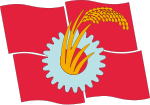Japanese Communist Party 日本共産党 Nihon Kyōsan-tō | |
|---|---|
 | |
| Abbreviation | JCP |
| Chairperson | Tomoko Tamura |
| Secretary-General | Akira Koike[1] |
| Representatives leader | Chizuko Takahashi |
| Councillors leader | Tomoko Kami |
| Founded | 15 July 1922[2] |
| Headquarters | 4-26-7 Sendagaya, Shibuya, 151-8586 Japan[3] |
| Newspaper | Shimbun Akahata |
| Youth wing | Democratic Youth League of Japan |
| Membership (January 2024) | |
| Ideology | |
| Political position | Left-wing to far-left |
| International affiliation | IMCWP[8] |
| Colors | Red[9] |
| Councillors | 11 / 248 |
| Representatives | 8 / 465 |
| Prefectural assembly members | 113 / 2,644 |
| Municipal assembly members | 2,226 / 29,135 |
| Election symbol | |
 | |
| Party flag | |
 | |
| Website | |
| |
The Japanese Communist Party (日本共産党, Nihon Kyōsan-tō, abbr. JCP) is a communist party in Japan. Founded in 1922, it is the oldest political party in the country. It has 250,000 members as of January 2024, making it one of the largest non-governing communist parties in the world. The party is chaired by Tomoko Tamura, who replaced longtime leader Kazuo Shii in January 2024.
The JCP was repressed by the Japanese government in the three decades immediately following its founding. The Allied occupation of Japan legalized the JCP after World War II, but the party's unexpected success in the 1949 general election led to the "Red Purge", in which the Japanese government removed tens of thousands of actual and suspected communists from their jobs. The Soviet Union encouraged the JCP to respond with a violent revolution; the consequent internal debate fractured the party into several factions. The dominant faction, backed by the Soviets, waged an unsuccessful guerrilla campaign in Japan's rural areas, which undercut the party's public support.
In 1958, Kenji Miyamoto became the JCP's leader and moderated the party's policies, abandoning the previous line of violent revolution. Miyamoto also began distancing the JCP from the Eastern Bloc in the 1960s. The party maintained a neutral stance during the Sino-Soviet split, declared its support for multi-party democracy in opposition to the one-party politics of China and the Soviet Union, and purged pro-Soviet or Chinese members. His efforts to regain electoral support were particularly successful in urban areas such as Osaka, Kyoto, and Tokyo, and the JCP worked with the Japan Socialist Party (JSP) in the 1970s to elect a number of progressive mayors and governors. By 1979, the JCP held about 10% of the seats in the National Diet. The party saw a brief electoral resurgence after the collapse of the JSP in 1996; however, the party has generally been in decline since in terms of electoral results and party membership.
The party at present advocates the establishment of a democratic society based on pacificism. It believes that this objective can be achieved by working within an electoral framework while carrying out an extra-parliamentary struggle against "imperialism and its subordinate ally, monopoly capital". As such, the JCP does not advocate violent revolution but rather a "democratic revolution" to achieve "democratic change in politics and the economy". It accepts the current constitutional position of the emperor but opposes the involvement of the Imperial House in politics. A staunchly anti-militarist party, the JCP firmly supports Article 9 of the Japanese Constitution and seeks to dissolve the Japan Self-Defense Forces. It opposes Japan's military alliance with the United States as an unequal relationship and infringement of Japan's national sovereignty.
- ^ "JCP elects new leadership". 12 April 2016. Retrieved 7 June 2016.
The Japanese Communist Party 5th Central Committee Plenum on 11 April relieved Yamashita Yoshiki (House of Councilors member) of his duty as secretariat head for health reasons and elected Koike Akira (House of Councilors member and currently JCP vice chair) to the position.
- ^ Uno 1991, p. 1030.
- ^ Cite error: The named reference
Bloombergwas invoked but never defined (see the help page). - ^ Cite error: The named reference
NHK 19 Jan 2024was invoked but never defined (see the help page). - ^ Hayes 2018, p. 81: "As a party committed to an ideological position, the JCP suffers even more than other opposition parties from the ideological neutrality of the Japanese voter. Any effort to mute its Marxist orientation would bring into question its very raison d'être. Moreover membership in the international communist movement is a liability."
- ^ "Nihon Kyōsantō kōryō" 日本共産党綱領 [Program of the Communist Party of Japan]. Japanese Communist Party (in Japanese). 18 January 2020.
- ^ Cite error: The named reference
East Asia Forumwas invoked but never defined (see the help page). - ^ Communist and Workers' Parties
- ^ 日本に定着するか、政党のカラー [Will the colors of political parties settle in Japan?] (in Japanese). Nikkei, Inc. 21 October 2017. Retrieved 29 May 2020.